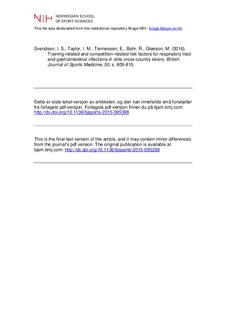| dc.contributor.author | Svendsen, Ida S. | |
| dc.contributor.author | Taylor, Ian M. | |
| dc.contributor.author | Tønnesen, Espen | |
| dc.contributor.author | Bahr, Roald | |
| dc.contributor.author | Gleeson, Michael | |
| dc.date.accessioned | 2016-11-01T12:37:16Z | |
| dc.date.available | 2016-11-01T12:37:16Z | |
| dc.date.issued | 2016-03-03 | |
| dc.identifier.citation | British Journal of Sports Medicine, 2016, 50, 809-815 | nb_NO |
| dc.identifier.uri | http://hdl.handle.net/11250/2418620 | |
| dc.description | Dette er siste tekst-versjon av artikkelen, og den kan inneholde små forskjeller fra forlagets pdf-versjon. Forlagets pdf-versjon finner du på bjsm.bmj.com /
This is the final text version of the article, and it may contain minor differences from the journal's pdf version. The original publication is available at bjsm.bmj.com | nb_NO |
| dc.description.abstract | Aim: To determine risk factors for respiratory tract and gastrointestinal infections in elite cross-country skiers.
Methods: Self-reported training and inefction data for 37 elite cross-country skiers from 2007 to 2015 were analysed. Multilevel logistic regression equations were constructed with infection incidence and symptom duration as outcome variables, and sex, performance level, season, training phase, competition, air travel, altitude exposure, and training characteristics as independent variables.
Results: Data for 7,016 person-weeks were analysed, including 464 infection events and 110,959 hours of training. Athletes reported median (range): 3 (1-7) respiratory and/or gastrointestinal infections per year, with symptoms lasting 5 (1-24) days. During the winter, infections occurred more frequently (odds ratio 2.09, P<0.001) and lasted longer (b=0.043, P<0.001) compared to summer. Competition and air travel increased the risk of infection, with odds ratios of 2.93 (95% CI: 2.24-3.83) and 4.94 (95% CI: 3.74-6.53), respectively (P<0.001). Athletes with higher Training Monotony had lower risk of infection (odds ratio 0.87 (95% CI: 0.73-0.99), P<0.05). Other training variables were not associated with infection. Athletes who had won an Olympic/World Championship medal reported shorter duration of symptoms compared to less successful athletes (b=-0.019, P<0.05) resulting in significantly fewer annual illness days median (range): 14 (6-29) vs. 22 (8-43) days/year.
Conclusions: Air travel and competition are major risk factors for respiratory tract and gastrointestinal infections in this population. Athletes whose training programmes incorporate large fluctuations in training load appear to be more susceptible to infection. A robust immune system capable of recovering quickly from infection may be associated with success in elite cross-country skiing. | nb_NO |
| dc.language.iso | eng | nb_NO |
| dc.publisher | BMJ | nb_NO |
| dc.subject | infection | nb_NO |
| dc.subject | risk factor | nb_NO |
| dc.subject | athletes | nb_NO |
| dc.subject | travel | nb_NO |
| dc.subject | altitude | nb_NO |
| dc.title | Training-related and competition-related risk factors for respiratory tract and gastrointestinal infections in elite cross-country skiers | nb_NO |
| dc.type | Journal article | nb_NO |
| dc.type | Peer reviewed | nb_NO |
| dc.subject.nsi | VDP::Social science: 200::Social science in sports: 330::Other subjects within physical education: 339 | nb_NO |
| dc.source.journal | British Journal of Sports Medicine | nb_NO |
| dc.identifier.doi | 10.1136/bjsports-2015-095398 | |
| dc.description.localcode | Seksjon for idrettsmedisinske fag / Department of Sports Medicine | nb_NO |
